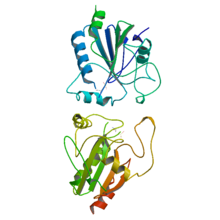Peroxidase
| Peroxidase | |||||||||
|---|---|---|---|---|---|---|---|---|---|

Glutathione Peroxidase 1
|
|||||||||
| Identifiers | |||||||||
| Symbol | peroxidase | ||||||||
| Pfam | PF00141 | ||||||||
| InterPro | IPR002016 | ||||||||
| PROSITE | PDOC00394 | ||||||||
| SCOP | 1hsr | ||||||||
| SUPERFAMILY | 1hsr | ||||||||
|
|||||||||
| Available protein structures: | |
|---|---|
| Pfam | structures |
| PDB | RCSB PDB; PDBe; PDBj |
| PDBsum | structure summary |
Peroxidases (EC number 1.11.1.x) are a large family of enzymes that typically catalyze a reaction of the form:
For many of these enzymes the optimal substrate is hydrogen peroxide, but others are more active with organic hydroperoxides such as lipid peroxides. Peroxidases can contain a heme cofactor in their active sites, or alternately redox-active cysteine or selenocysteine residues.
The nature of the electron donor is very dependent on the structure of the enzyme.
While the exact mechanisms have yet to be determined, peroxidases are known to play a part in increasing a plant's defenses against pathogens. Peroxidases are sometimes used as histological marker. is used as a soluble, easily purified model for .
The glutathione peroxidase family consists of 8 known human isoforms. Glutathione peroxidases use glutathione as an electron donor and are active with both hydrogen peroxide and organic hydroperoxide substrates. Gpx1, Gpx2, Gpx3, and Gpx4 have been shown to be selenium-containing enzymes, whereas Gpx6 is a selenoprotein in humans with cysteine-containing homologues in rodents.
Amyloid beta, when bound to heme, has been shown to have peroxidase activity.
A typical group of peroxidases are the haloperoxidases. This group is able to form reactive halogen species and, as a result, natural organohalogen substances.
...
Wikipedia
